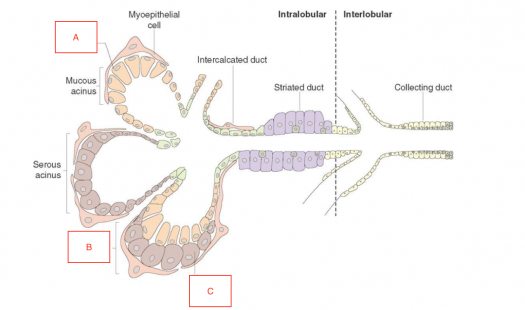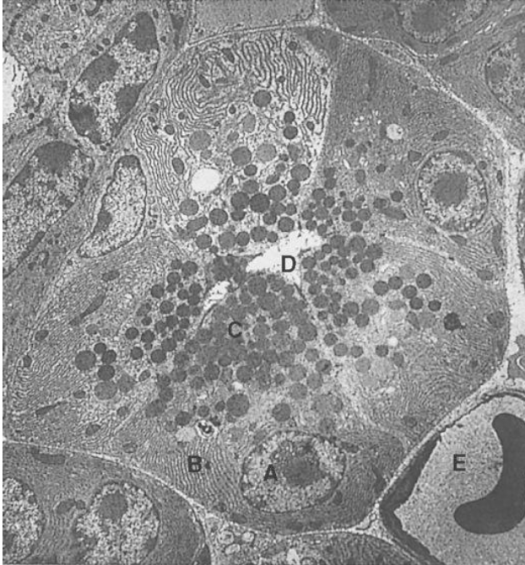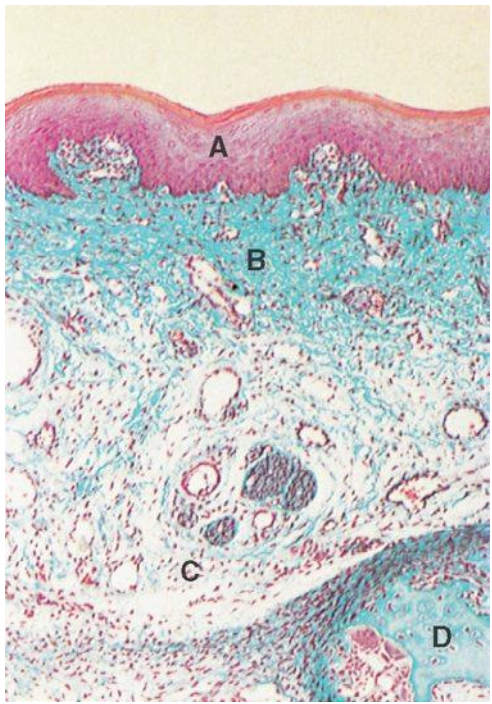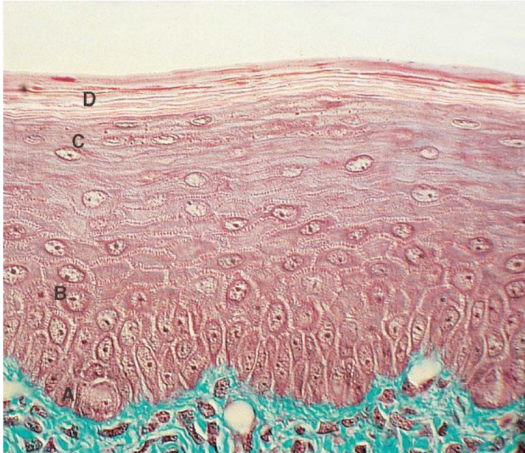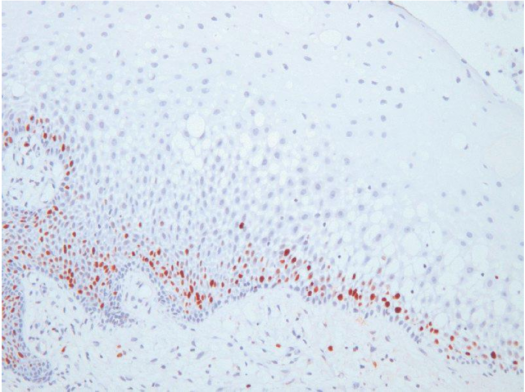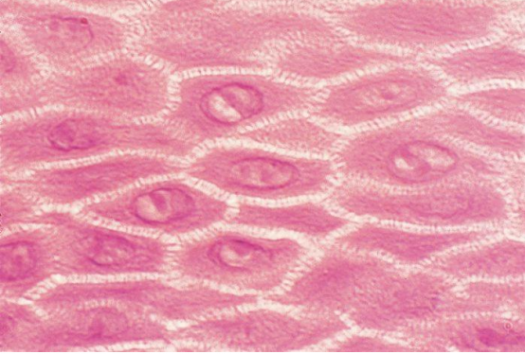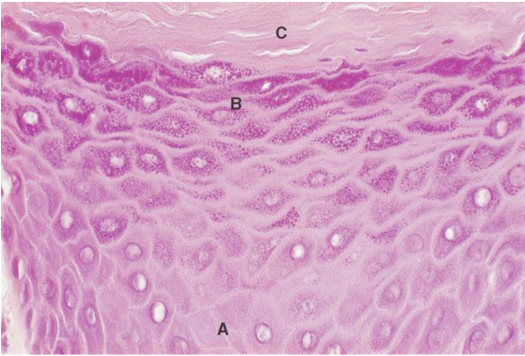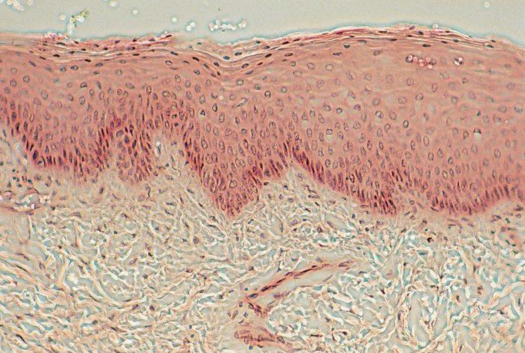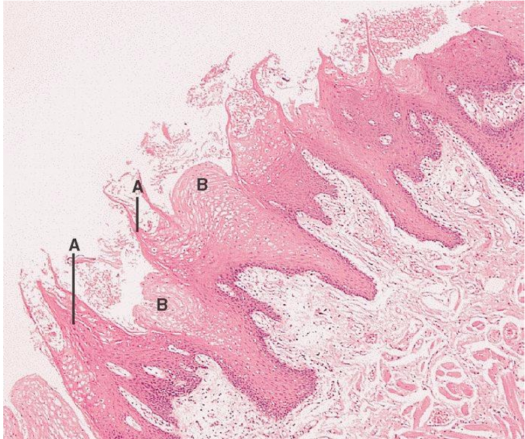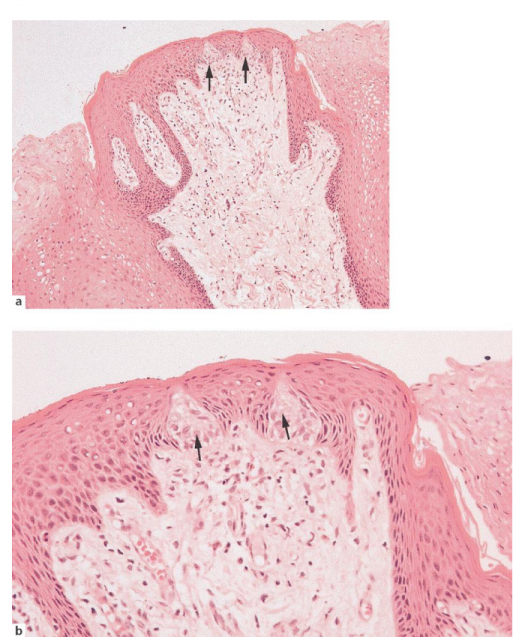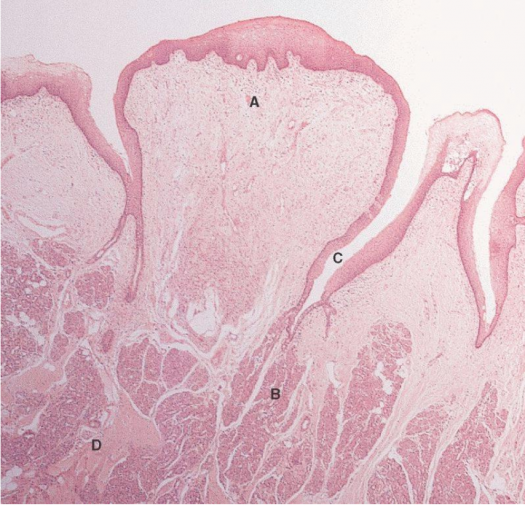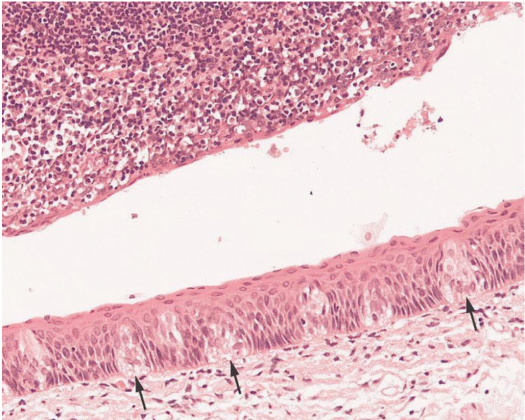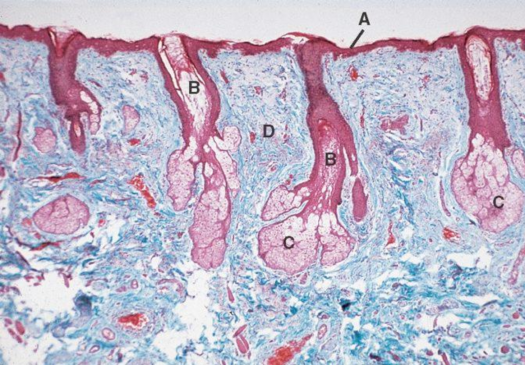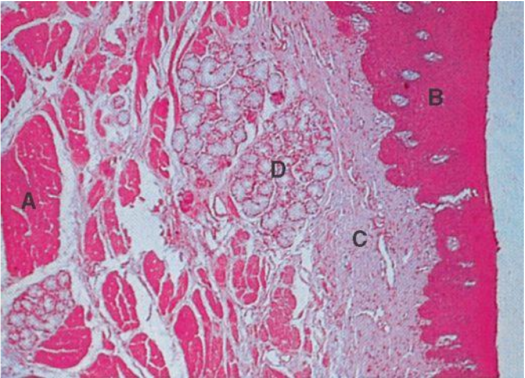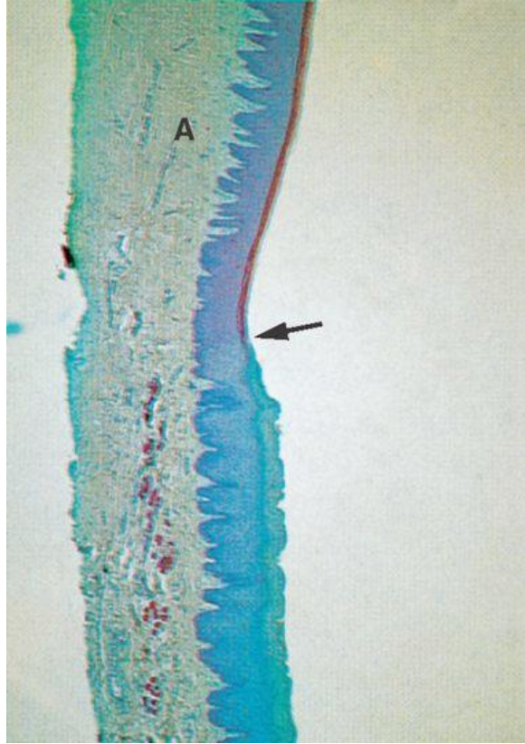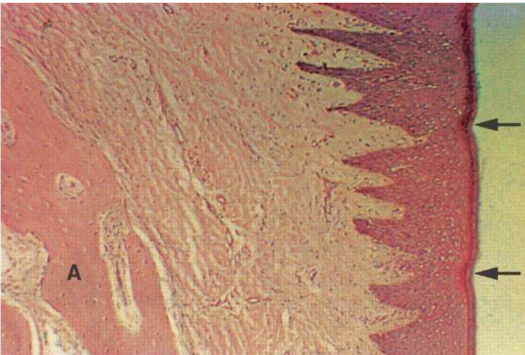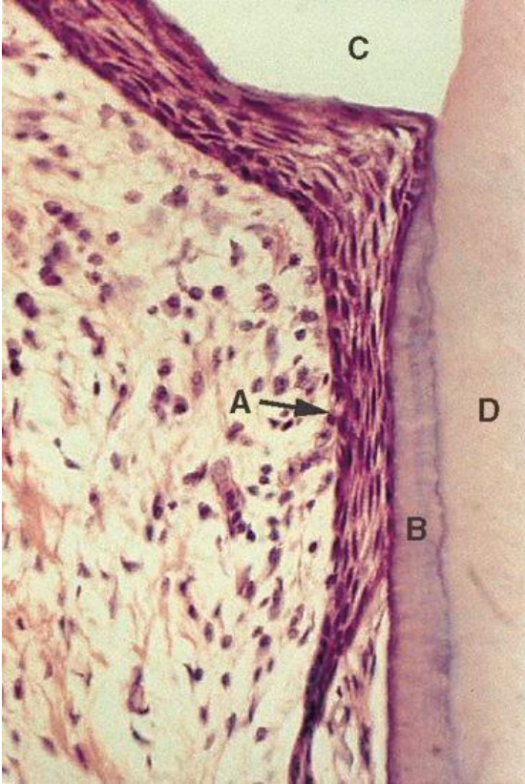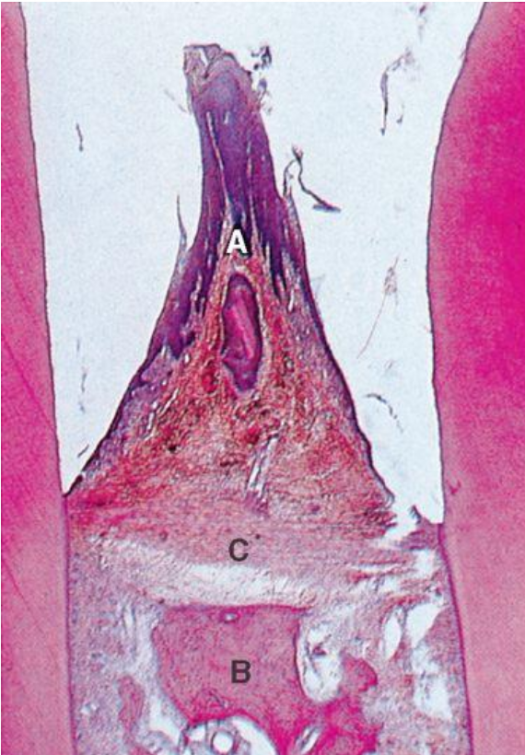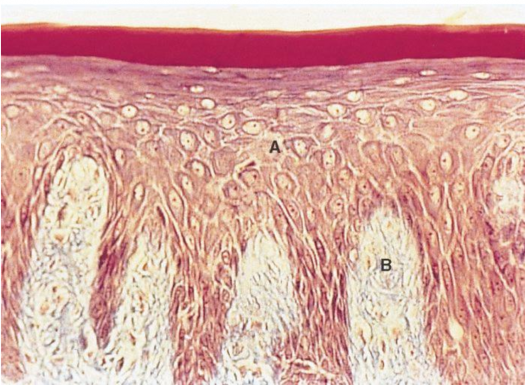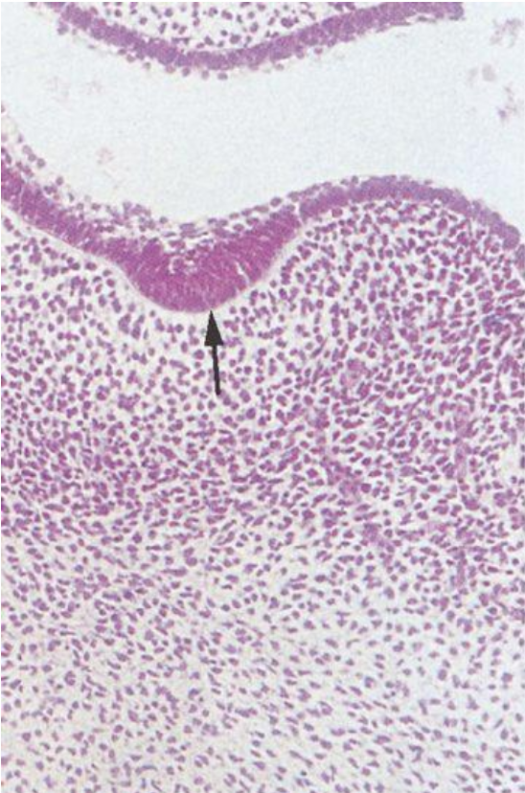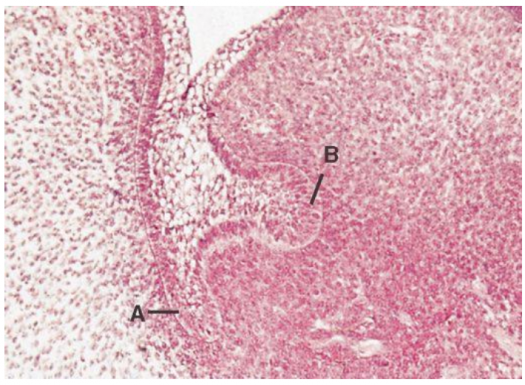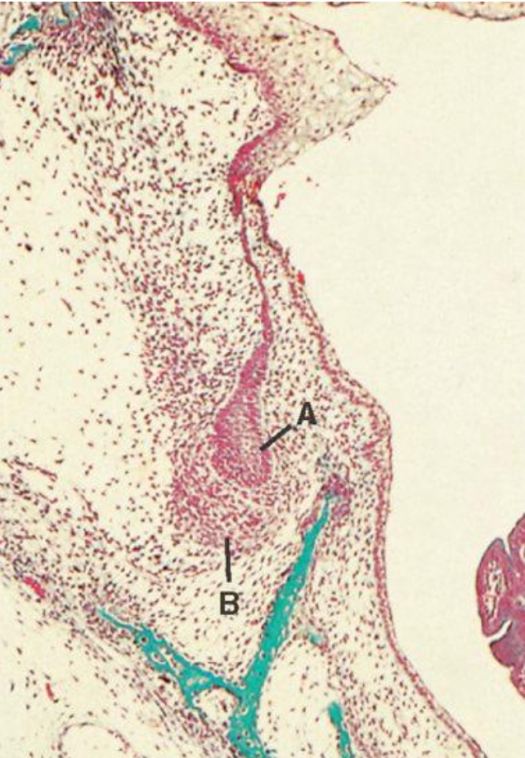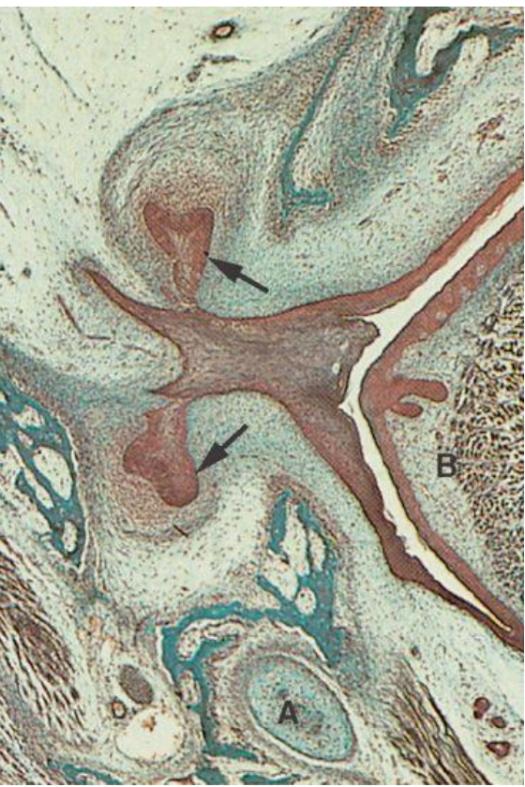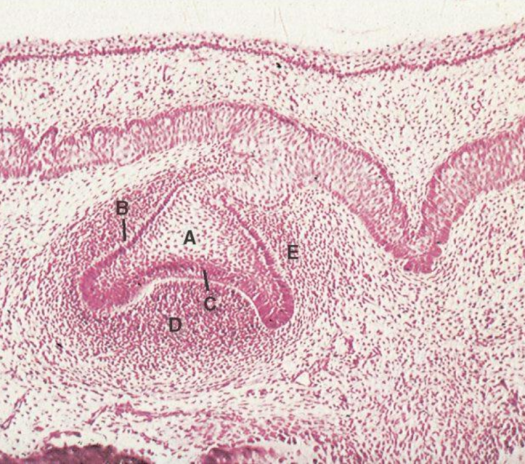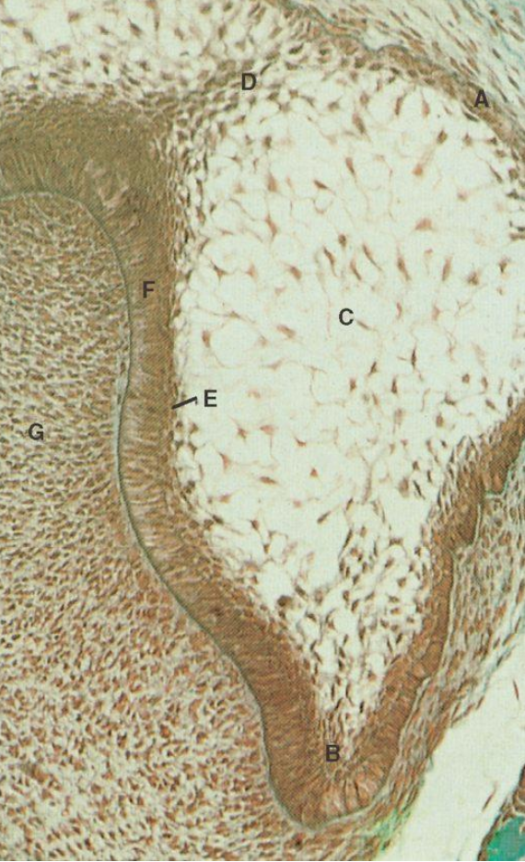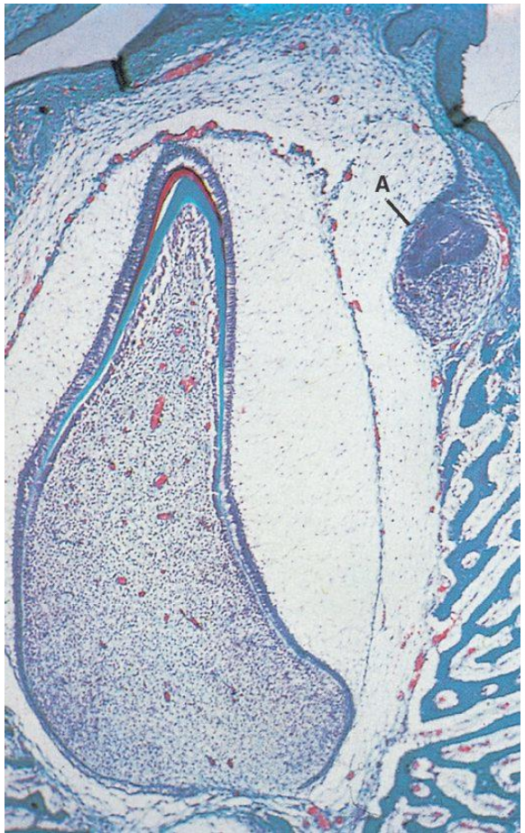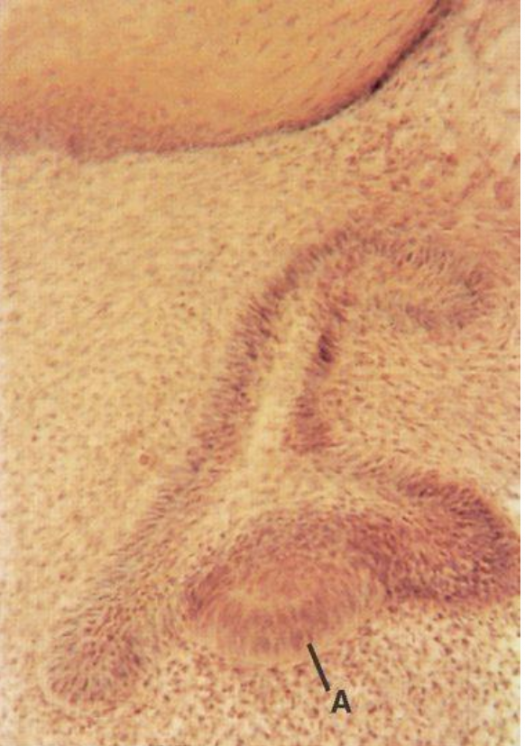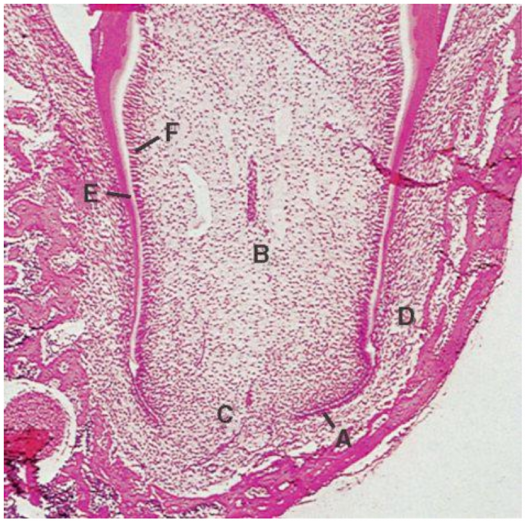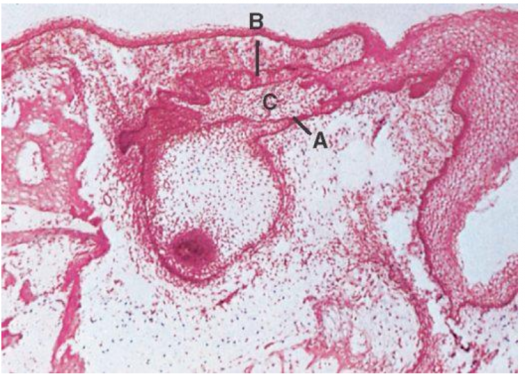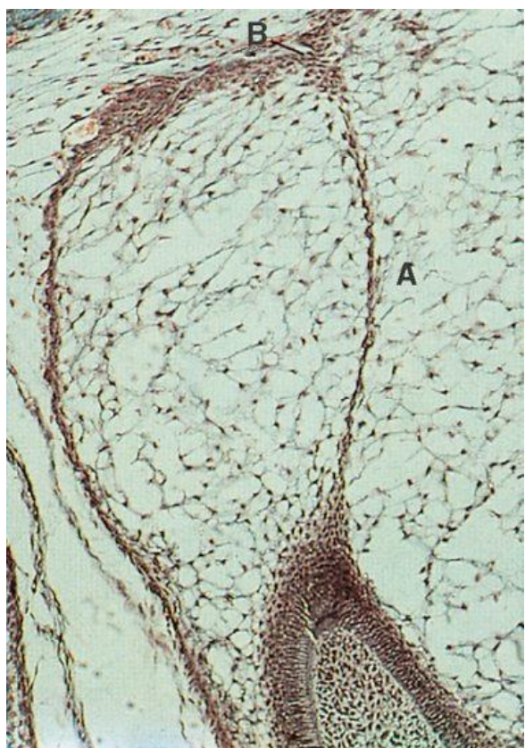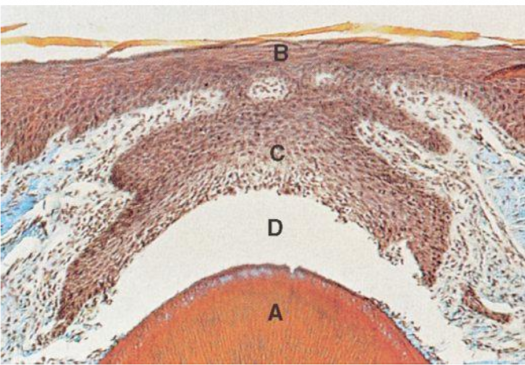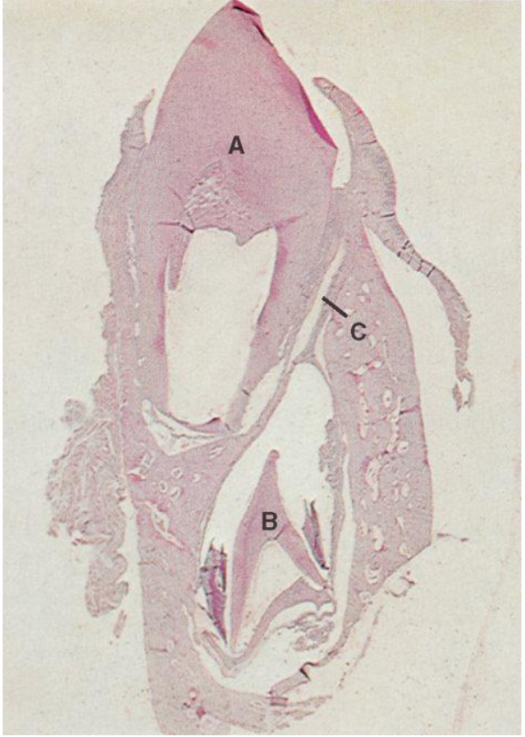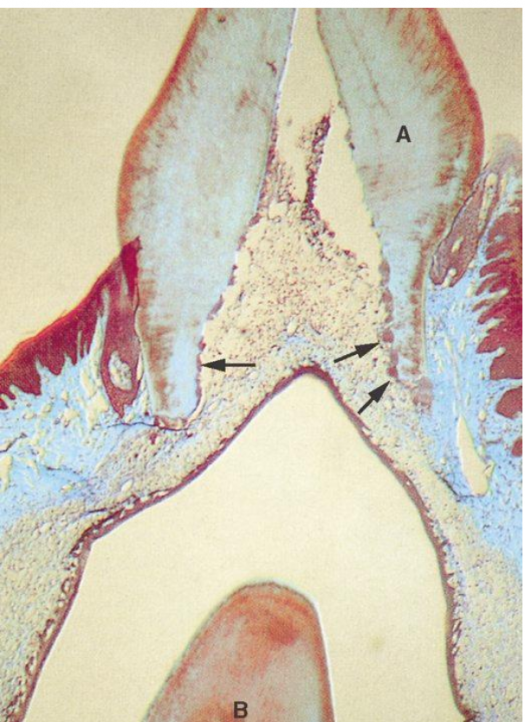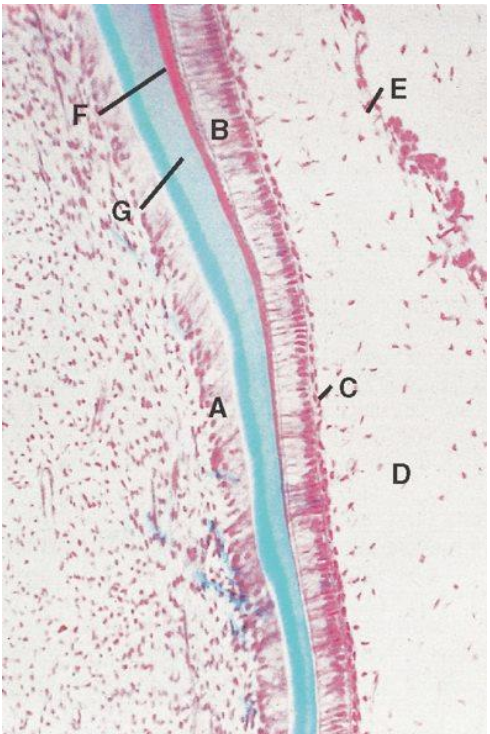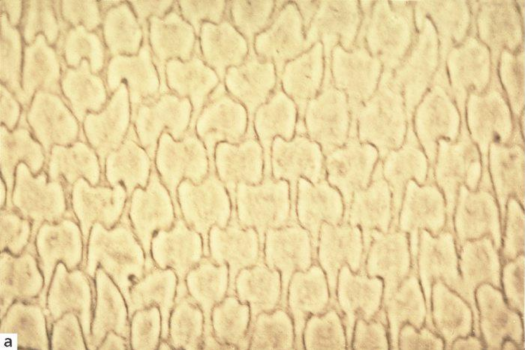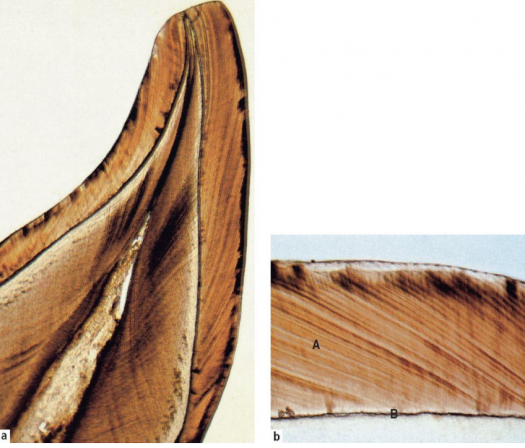Dental Histology Hardest Exam: Quiz!
(441).jpg)
.
- 1.
What is "A" in the Photo
Explanation
elongated, cuboidal shape with flat nucleusRate this question:
- 2.
What is "B" in the photo
Explanation
surrounds serous cells, contracts cells and pushes saliva into oral cavityRate this question:
- 3.
Salivary glands consist of 2 elements, what are they? (separate answer with comma)
Explanation
The salivary glands are composed of two main elements: glandular secretory tissue, also known as parenchyma, and supporting connective tissue, also known as stroma. The glandular secretory tissue is responsible for producing and secreting saliva, while the supporting connective tissue provides structural support and helps maintain the shape and integrity of the glands. These two elements work together to ensure the proper functioning of the salivary glands.Rate this question:
- 4.
What kind of cells are the arrows pointing at?
Explanation
Lie between basal lamina and basal membranes of acini cells and duct cells.
• Dendritic cells with stellate shaped body,
• Also present in intercalated ducts.
• Have parasympatheic and sympatheitc
stimulation.
• Functions include: supporting parenchyma,
increasing initial flow of saliva, contributing to
secretory pressure and reducing luminal flowRate this question:
- 5.
What kind of cell is this? What is "C" representing (separate answer with comma)
Explanation
Saliva is produced in and secreted from salivary glands. The basic secretory units of salivary glands are clusters of cells called an acini. These cells secrete a fluid that contains water, electrolytes, mucus and enzymes, all of which flow out of the acinus into collecting ductsRate this question:
- 6.
What is this picture showing? What is represented by "B' (separate answer with a comma)
Explanation
• Lining of the oral cavity
• Epithelium with an
underlying connective
tissue (the lamina
propria).
• Third layer (the
submucosa) is found
between the lamina
propria and the
underlying bone (palate)
or muscle (cheeks and
lips).
2 LAMINA PROPRIA LAYERS =
Superficial, papillary layer between the
epithelial ridges, in which the collagen fibres are thin
and loosely arranged.
-Deep, reticular layer dominated by thick,
parallel bundles of collagen fibres.
Section showing regions of oral mucosa. A = stratified squamous epithelium; B =
lamina propria; C = submucosa; D = boneRate this question:
- 7.
The submucosa layer consists of very tight connective tissue containing fat deposits and glands. Larger nerves and blood vessels also run through the submucosa.
- A.
True
- B.
False
Correct Answer
B. FalseExplanation
The submucosa layer consists of loose connective tissue containing fat deposits and glands. Larger nerves and blood vessels also run through the submucosa.Rate this question:
-
- 8.
What is this photo of? What layer is "B" called? (separate answers by a comma)
Correct Answer
keratinized oral epithelium, prickle cell layerExplanation
Section showing layers of keratinized oral epithelium.
A = basal layer (single cell layer, cuboidal cells, stem cells originate here that generate "transit-amplifying cells that give rise to replacement keratinocytes")
B = prickle cell layer (above basal cell layer, round or ovoid, desmosomes increase in # and become more obvious than basal)
C = granular layer (increased in maturation, cells are larger and flatter contain keratohyaline granules w/ filaggrin that binds keratin filaments together into a stable network)
D = keratinized layer (final stage of maturation, loss of all organelles, autolysis due to proteases. Filled entirely with tonofilaments surrounded by matrix protein filaggrin)Rate this question:
- 9.
What layer is this depicting?
Correct Answer
Basal cell layerExplanation
Section of oral epithelium showing cells undergoing cell replication (red stain).Rate this question:
- 10.
What layer is this?
Correct Answer
prickle cell layerExplanation
Characterized by desmosomes between cells that look 'prickly"Rate this question:
- 11.
What layer is "B" depicting?
Correct Answer
granular layerExplanation
granular layer is between prickle (A) and keratinized (C)Rate this question:
- 12.
This photo is depicting orthokeratinized oral epithelium characterized by the presence of small and shrunken nuclei.
- A.
True
- B.
False
Correct Answer
B. FalseExplanation
In some areas such as the gingiva the nuclei may be retained, although small and shrunken. These cells are described as parakeratinized (in contrast to the more usual orthokeratinized cells without nuclei)Rate this question:
-
- 13.
This photo depicts lining epithelium of the oral mucosa. Is there keratin present in this photo?
Correct Answer
noExplanation
-Non keratinized epithelium , Lack of keratohylaine granules , Absence of filaggrin , less developed and dispersed tonofilaments present in lining epithelium.
-The outer layers are usually termed the intermediate (stratum intermedium) and superficial (stratum superficiale) layers.Rate this question:
- 14.
Which of the following is not a type of oral mucosa?
- A.
Masticatory
- B.
Specalized
- C.
Keratinized
- D.
Lining
Correct Answer
C. KeratinizedExplanation
Within the oral cavity about 60% of the mucosa is lining mucosa, about 25% of the mucosa is masticatory mucosa and the
remaining 15% specialized mucosa.
Masticatory mucosa is found where there is high
compression and friction, and is characterized by a
keratinized epithelium and a thick lamina propria. Eg :
gingiva and palate
• Lining mucosa is not subject to high levels of friction but
must be mobile and distensible. It is thus non-keratinized
and has a loose lamina propria. Within the lamina
propria, the collagen fibres are arranged as a network to
allow free movement, and the elastic fibres allow recoil to
prevent the mucosa being chewed. Commonly, lining
mucosa also has a submucosa. The lips, cheeks, alveolus,
floor of the mouth, ventral surface of the tongue and soft
palate have a lining mucosa.
• Specialized mucosa : the specialized gustatory mucosa of
the dorsum of the tongue and where the vermilion zone
forms a transition between the skin and the oral mucosa.Rate this question:
-
- 15.
What kind of taste bud is pictured?
- A.
Filliform
- B.
Fungiform
- C.
Circumvalate
- D.
Foliate
Correct Answer
A. FilliformExplanation
Section showing dorsum of anterior two-thirds of tongue covered by keratinized
filiform papillae (A) with non-keratinized regions between (B)Rate this question:
-
- 16.
What kind of papilla is pictured?
- A.
Filliform
- B.
Fungiform
- C.
Circumvalate
- D.
Foliate
Correct Answer
B. FungiformExplanation
Section of fungiform papilla on dorsal surface of anterior part of tongue
showing taste buds (arrowed). The papilla is keratinized (H & E; ×120). (b) High-power view
of surface of fungiform papilla seen in (a), showing taste buds (arrows) (×240).Rate this question:
-
- 17.
What kind of papilla is pictured?
- A.
Filliform
- B.
Fungiform
- C.
Circumvalate
- D.
Foliate
Correct Answer
C. CircumvalateExplanation
Section of circumvallate papilla (A). Serous glands (B) of von Ebner empty via ducts
into the base of the trench (C) surrounding the papilla, which is not raised above the surface
of the tongue. D = muscle of tongue.Rate this question:
-
- 18.
What kind of papilla is pictured?
- A.
Filliform
- B.
Fungiform
- C.
Circumvalate
- D.
Foliate
Correct Answer
D. FoliateExplanation
Section of foliate papilla showing taste buds (arrowed). Note the adjacent
lymphoid material characteristic of the posterior part of the tongue.Rate this question:
-
- 19.
What structure is the image picturing? What is "C'? (separate answer with comma)
Correct Answer
lip, sebaceous glandExplanation
Section of skin of lip. A = keratinized epidermis; B = shaft of hair; C = sebaceous
gland; D = dermis.Rate this question:
- 20.
This photo is picturing the vermillion "red-zone" of the lip
- A.
True
- B.
False
Correct Answer
A. TrueExplanation
Section of red zone of lip. A = keratinized epithelium; B = lamina propria. Note the
folded interface between epithelium and lamina propria bringing blood vessels (C) close to
the surface.Rate this question:
-
- 21.
What is this photo of? What is "D"? (separate answers w/ comma)
Correct Answer
buccal mucosa, salivary glandExplanation
This photo is of the buccal mucosa, which is the lining of the inner cheeks. Additionally, "D" refers to the salivary gland, which is a gland that produces saliva and is located in the buccal mucosa.Rate this question:
- 22.
In this photo of gingiva, what is the arrow pointing to?
Correct Answer
mucogingival junctionExplanation
Section of the attached gingiva (A) and alveolar mucosa stripped off from underlying
bone. The arrow points to the sharp demarcation site of the mucogingival junction. Note the
keratinized epithelium covering the attached gingiva, the non-keratinized epithelium covering
the alveolar mucosa and the numerous blood vessels in the alveolar mucosa.Rate this question:
- 23.
This photo is of attached gingiva, what are the arrows indicating?
Correct Answer
stipplingExplanation
Section of the attached gingiva. The epithelium is a keratinized stratified squamous
epithelium. The lamina propria is dense and relatively avascular and the interface with the
epithelium is highly folded. The lamina propria is directly attached to the underlying alveolar
bone (A), forming a mucoperiosteum. Arrows indicate surface stippling.Rate this question:
- 24.
What is "A" indicating? What is "B"? (separate answers w/ comma)
Correct Answer
junctional epithelium, rootExplanation
Demineralized section showing junctional epithelium (A) having proliferated
rootwards to lie on cemental surface of root (B). C = enamel space; D = dentine.Rate this question:
- 25.
This photo is showing interdental gingiva. "B" is showing the alveolar crest
- A.
True
- B.
False
Correct Answer
A. TrueExplanation
Demineralized section showing the interdental gingiva (A) between two cheek teeth
in the anteroposterior plane. B = alveolar crest; C = transseptal group of gingival fibresRate this question:
-
- 26.
True or false, this image is of keratinized epithelium of the soft palate
Correct Answer
falseExplanation
Section of the masticatory keratinized epithelium (A) of the hard palate. Note the
highly folded interface with the lamina propria (B).Rate this question:
- 27.
This photo was taken during the 6th week of development. What is the arrow point to?
Correct Answer
primary epithelial bandExplanation
Oral epithelium thickens
and invaginates into the
mesenchyme to form a
primary epithelial band.
• The first sign of tooth
development is the
condensation of
mesenchymal tissue which
are ectomesenchymal
(neural crest) in origin,
having migrated into the
jaws from the margins of
the neural tube.Rate this question:
- 28.
This image was taken during the 7th week of development. What is "A"?
Correct Answer
vestibular laminaExplanation
The vestibular lamina (A) and dental lamina (B) seen at the 7th week of intra-uterine life.
the primary epithelial band divides into two processes: a
buccally located vestibular lamina and a lingually situated dental
lamina.
• The vestibular lamina contributes to the development of the vestibule
of the mouth, delineating the lips and cheeks from the tooth-bearing
regions. Cells of the vestibular lamina proliferate, with subsequent
degeneration of the central epithelial cells to produce the sulcus of
the vestibule.Rate this question:
- 29.
The stages in tooth development consists of 1) Initiation, 2) Morphogenesis, 3) Histogenesis
- A.
True
- B.
False
Correct Answer
A. TrueExplanation
Initiation- the sites of the future teeth are established,
appearance of tooth germs along an invagination of the
oral epithelium called the dental lamina.
• Morphogenesis- the shape of the tooth is determined by a
combination of cell proliferation and cell movement.
• Histogenesis- differentiation of cells (begun during
morphogenesis) proceeds to give rise to the fully formed
dental tissues, both mineralized (i.e. enamel, dentine and
cementum) and unmineralized (i.e. dental pulp and
periodontium)Rate this question:
-
- 30.
What stage of morphodifferentation is this image? What is "A" and "B"? (separate w/ comma)
Correct Answer
bud stage, enamel organ, mesenchymal condensationExplanation
Bud stage of tooth development. A = enamel organ; B = mesenchymal condensationRate this question:
- 31.
What stage of morphodifferentiation is this image?
Correct Answer
cap stageExplanation
Early cap stage of tooth development (arrows). A = Meckel's cartilage; B = developing tongue
11th week
morphogenesis- the
deeper surface of the
enamel organ
invaginating to form a
cap-shaped structure.
• Poorly
histodifferentiated.
• External and internal
dental epithelium
forming.Rate this question:
- 32.
What stage of morphodifferentiation is this image in? What is "A"? (separate answer w/ comma)
Correct Answer
late cap stage, stellate reticulumExplanation
Late cap stage of tooth development. A = stellate reticulum; B = external enamel epithelium; C = internal enamel epithelium; D = dental papilla; E = dental follicle
12th week (late cap stage)- the central cells of the enlarging
enamel organ have become separated (although
maintaining contact by desmosomes), the intercellular
spaces containing significant quantities of
glycosaminoglycans. This is called stellate reticulum.
• The cells of the external enamel epithelium remain
cuboidal.
• Internal enamel epithelium cells become more columnar,
increase in RNA content and hydrolytic and oxidative
enzyme activity.
• The part of the mesenchyme lying beneath the internal
enamel epithelium is termed the dental papilla, while that
surrounding the tooth germ forms the dental follicle.Rate this question:
- 33.
This photo is of the Early Bell Stage. What week is this occurring at?
Correct Answer
14Explanation
14th week- further morphodifferentiation and
histodifferentiation of the tooth germ lead to the early
bell stage of the internal enamel epithelium broadly
maps out the occlusal pattern of the crown of the
tooth (differential mitosis).
• The future cusps and incisal margins are sites of
precocious cell maturation associated with cessation of
mitosis, while areas corresponding to the fissures and
margins of the tooth remain mitotically active. Thus,
cusp height is related more to continued downward
growth at the margin and fissures than to upward
extension of the cusps.
Dental lamina breaks down and the enamel organ
loses connection with the oral epithelium.
• A high degree of histodifferentiation is achieved
in the early bell stage.
• The enamel organ shows four distinct layers:
external enamel epithelium, stellate reticulum,
stratum intermedium and internal enamel
epithelium.
• The cervical loop at the margins of the enlarging
bell-shaped enamel organ is a site of mitotic
activity.Rate this question:
- 34.
The Enamel Organ consists of 4 distinct layers. Which of these layers actually forms the enamel?
- A.
External Enamel Epithelium
- B.
Stellate Reticulum
- C.
Internal Enamel Epithelium
- D.
Stratum Intermedium
- E.
All of the above
Correct Answer
C. Internal Enamel EpitheliumExplanation
Enamel organ shows four distinct layers:
- External enamel epithelium
- Stellate reticulum
- Stratum intermedium
- Internal enamel epithelium (forms enamel
whereas the first three layers provide support
to the developing tooth)Rate this question:
-
- 35.
The Late Bell stage is associated with the formation of hard dental tissues during Week 15
- A.
True
- B.
False
Correct Answer
B. FalseExplanation
week 18Rate this question:
-
- 36.
What stage during enamel and dentine formation is depicted here?
Correct Answer
late bell stageExplanation
Enamel and dentine formation
commencing at the tips of future cusps
(or incisal edges).
• Under the inductive influence of
developing ameloblasts (preameloblasts), the adjacent mesenchymal
cells of the dental papilla become
columnar and differentiate into
odontoblasts.
• The odontoblasts then become involved
in the formation of predentine and
dentine. The presence of dentine then
induces the ameloblasts to secrete
enamel.
Fig 21.16: Late bell stage (appositional stage) of tooth development. Dentine matrix stained
blue; enamel matrix stained red. A = permanent tooth.Rate this question:
- 37.
The Transitionary Structures are which of the following
- A.
Enamel knot
- B.
Dentine root
- C.
Enamel cord
- D.
Dentine reticulate
- E.
Dentine niche
- F.
Enamel niche
- G.
Odontoblasts
- H.
Late bell stage
- I.
Bell stage
Correct Answer(s)
A. Enamel knot
C. Enamel cord
F. Enamel nicheExplanation
The transitionary structures mentioned in the answer are all related to the development of enamel in teeth. Enamel knot, enamel cord, and enamel niche are all structures that form during tooth development and play a role in enamel formation. These structures are involved in the differentiation and organization of the cells that produce enamel. Therefore, they are considered transitionary structures in the process of enamel development.Rate this question:
-
- 38.
What transitionary structure is pictured?
Correct Answer(s)
enamel knotExplanation
– Localized mass of cells in the
centre of the internal enamel
epithelium.
– Forms a bulge into the dental
papilla, at the centre of the
enamel organ.
– It might play a role in the
formation of crown pattern
by outlining the central
fissure. However, it soon
disappears and seems to
contribute cells to the enamel
cord .
– The disappearance of the
enamel knot by the bell stage
may be associated with
apoptosis.Rate this question:
- 39.
This is a developing root, what is "B"?
Correct Answer(s)
dental papillaExplanation
The developing root. A =epithelial root sheath, B= dental papilla; C = primary
apical foramen; D = dental follicle; E = developing root dentine; F = odontoblast layerRate this question:
- 40.
What transitionary structure is pictured?
Correct Answer(s)
enamel nicheExplanation
The enamel niche is seen
where the tooth germ
appears to have a double
attachment to the dental
lamina (the lateral and
medial enamel strands).
These strands enclose the
enamel niche, which
appears as a funnel-shaped
depression containing
connective tissue.
– The functional significance
of the enamel niche is
unknown.
Fig 21.21: The enamel niche (C). A = lateral
enamel strand; B = medial enamel strandRate this question:
- 41.
What transitionary structure is pictured?
Correct Answer(s)
enamel cordExplanation
Strand of cells seen at the
early bell stage of
development extending from
the stratum intermedium into
the stellate reticulum.
– It overlies the incisal margin
of a tooth or the apex of the
first cusp to develop (primary
cusp).
– may be involved in the
process by which the cap
stage is transformed into the
bell stage (acting as a
mechanical tie) or that it is a
focus for the origin of stellate
reticulum cells.
Fig 21.20: The enamel cord (A). B = enamel navelRate this question:
- 42.
What is happening in this photo?
Correct Answer(s)
erupting deciduous molarExplanation
An erupting deciduous molar before its emergence into the oral cavity. A = enamel
space; B = developing roots; C = developing alveolar crypt; D = oral mucosa and overlying
connective tissue; E = reduced enamel epithelium .Rate this question:
- 43.
What is that arrow pointing to in this image of an erupting tooth?
Correct Answer(s)
reduced dental epitheliumExplanation
The soft tissues overlying the enamel space (A) of an erupting tooth. B = oral
epithelium; C = connective tissue between developing tooth and oral epithelium. Arrow
indicates the reduced enamel epitheliumRate this question:
- 44.
This photo is of an erupting tooth, with "C" and "B" fusing to make an epithelium lined pathway for the tooth. "D" is depicting enamel space.
- A.
True
- B.
False
Correct Answer
A. TrueExplanation
An erupting tooth (A) about to emerge into the oral cavity through an
epithelium-lined pathway as a result of fusion of the oral epithelium (B) and the reduced
enamel epithelium (C) D = enamel spaceRate this question:
-
- 45.
What is "C" pointing to?
Correct Answer
Gubernacular canalExplanation
A specialized feature associated with the erupting permanent tooth
is the presence of a gubernacular canal. The gubernacular canal
contains the gubernacular cord.
• The cord is composed of a central strand of epithelium (derived
from the dental lamina) surrounded by connective tissue. The
connective tissue is organized into inner and outer layers. Collagen
fibres of the inner layer show greater organization and run mainly
parallel to the long axis of the epithelium. In the outer layer, the
collagen fibres are fewer and less organized. Differences between
the layers can also be discerned with respect to the vasculature, the
vessels in the outer layer being larger. During eruption, the
gubernacular cords decrease in length but increase in thickness and
become less dense.
• Surgical removal of the cord does not prevent eruption of the
permanent tooth.Rate this question:
- 46.
In this photo of a resorbing tooth, what are the arrows pointing to?
Correct Answer
odontoclastsExplanation
Buccolingual section through a resorbing deciduous tooth (A) and its erupting
successor (B). Arrows indicate multinucleated odontoclasts
Resorption of the hard tissues of the deciduous tooth
takes place by the activity of multinucleated osteoclastlike cells termed odontoclasts. The vascular, resorbing
tissue has been termed the resorbing organ of Tomes.
• Odontoclasts lie within resorption lacunae (Howship's
lacunae). Odontoclasts, like osteoclasts, differentiate
from circulating monocyte-like cells. They are
vacuolated and have long cytoplasmic processes, an
abundance of ribosomes and a large number of
mitochondria. Howship's lacunae in resorbing teeth
tend to be larger and more spherical than lacunae in
bone.Rate this question:
- 47.
Because resorption of teeth is not continuous, repair occurs as well with cementum by cementoblast type cells. If the repair process prevails over the resorption, this is called?
Correct Answer
AnkylosisExplanation
Resorption of deciduous teeth is not a continuous
process. During rest periods, reparative tissue
may be formed, leading to a reattachment of the
periodontal ligament. The tissue of repair is
cementum-like and the cells responsible for its
formation are similar in appearance to
cementoblasts . If the repair process prevails over
the resorption, the tooth may become ankylosed
to the surrounding bone, with loss of the
periodontal ligament . Ankylosis may also be
caused by trauma or infection of a toothRate this question:
- 48.
What is this picture showing? What is labelled by "B"? (separate answers with a comma)
Correct Answer
initial enamel formation, ameloblastsExplanation
Initial stage of enamel formation. A = odontoblasts; B = ameloblasts; C = stratum
intermedium D = stellate reticulum; E = external enamel epithelium; F = developing enamel; G =
developing dentineRate this question:
- 49.
What type of enamel prism structure is this?
Correct Answer
keyholeExplanation
The three prism patterns seen in human enamel. In pattern I enamel the prisms
are circular. In pattern II enamel the prisms are aligned in parallel rows. In pattern III
enamel the prisms are arranged in staggered rows such that the tail of a prism lies between
two heads in the next row, giving a keyhole appearance.Rate this question:
- 50.
1) What are the other names for short and long periods of incremental lines respectively? (separate answers w/ comma). This photo represents periods of long incremental periods.
Correct Answer
cross-striations, enamel striaeExplanation
During development changes in the enamel
secretory rhythm, chemical composition
and/or the position of the developing enamel
front are recorded as incremental features.
There are two main types of incremental line:
short period (cross-striations) and long period
(enamel striae)Rate this question:
Quiz Review Timeline +
Our quizzes are rigorously reviewed, monitored and continuously updated by our expert board to maintain accuracy, relevance, and timeliness.
-
Current Version
-
Mar 22, 2023Quiz Edited by
ProProfs Editorial Team -
Apr 03, 2018Quiz Created by
Siroishka
 Back to top
Back to top



